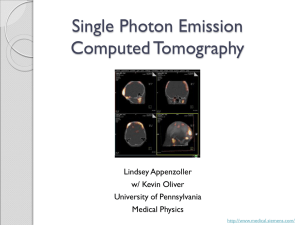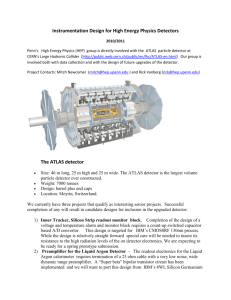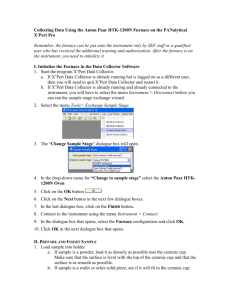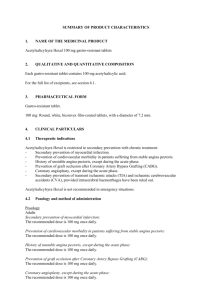Chem 361 Final Exam December
advertisement
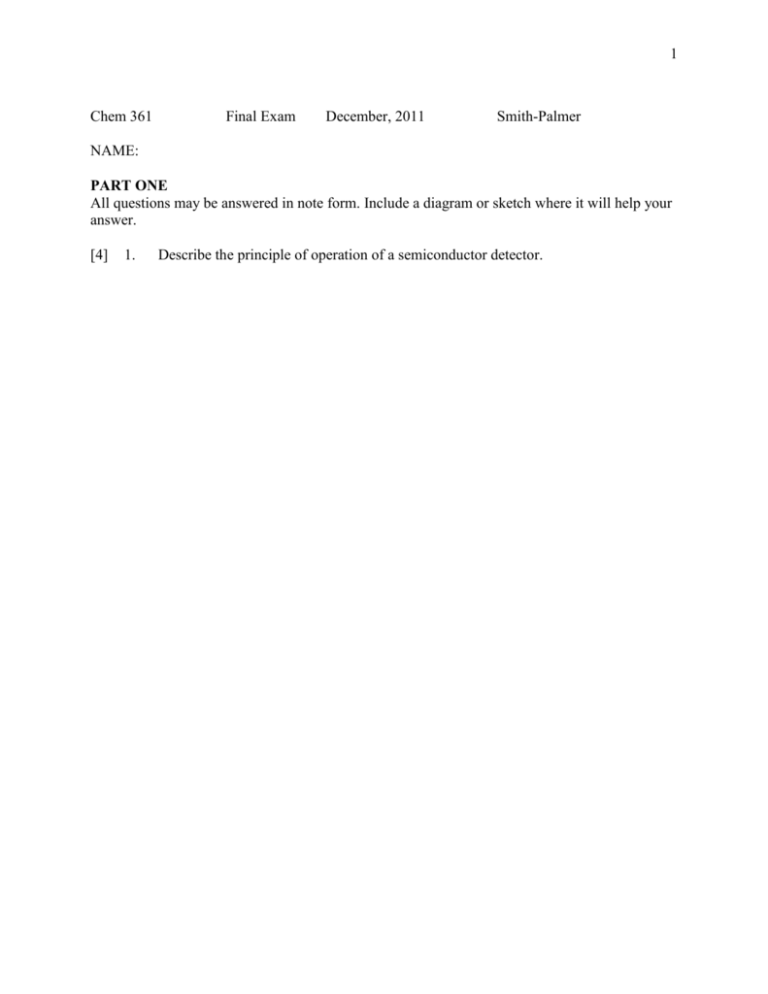
1 Chem 361 Final Exam December, 2011 Smith-Palmer NAME: PART ONE All questions may be answered in note form. Include a diagram or sketch where it will help your answer. [4] 1. Describe the principle of operation of a semiconductor detector. 2 [12] Semiconductor detectors can be used to detect gamma rays, infra-red, and UV-visible radiation. For each of these wavelength ranges, sketch a spectrum for a species (atom, molecule) of your choice in an instrument of your choice, using the axes below. Please label the axes in each case and state which instrument is involved and what species the spectrum belongs to. eg polarograph, NaCl gamma infra-red UV-visible 3 [4] For two of the spectra above, draw a labeled energy level diagram with notes to explain the origin of the spectral peaks and the transitions involved. 4 [12] 2. EITHER For each spectral region, give an example of a semiconductor detector that can be used there. For each semiconductor detector, ( gamma rays, infra-red, and UVvisible), give an alternate detector that could be used, and, FOR EACH ALTERNATIVE DETECTOR, give four or five key words (or phrases) that essentially describe the principle of operation. Spectral Example Alternative 4-5 key words (or phrases) that region of detector essentially describe the principle of semiconductor operation of the alternative detector. detector gamma infra-red UVvisible 5 OR (also a total of 12 pts) [1] What does Laser stand for [1] What are the properties of laser light? [3] Draw a labeled energy level diagram for a material used to produce laser light. Note the features critical for lasing. 6 [4] Give two instruments where a laser is used and for each, say why the use of the laser (as opposed to another light source) is necessary. [3] What light sources are used in the following instruments: UV absorption Visible absorption FTIR Fluorescence Near IR Raman 7 [4] 3. What wavelength region is used in the following forms of spectroscopy? Give approximate ranges in nm. Raman Infra red Fluorescence Atomic absorption [3] 4. What window materials (in sample cells, and in the instruments) are required for wavelengths in the visible region: UV region: IR region: [3] 5. What materials block alpha particles: Beta(negative) particles: Gamma rays: 8 6. Your analytical lab, in Antigonish, is going to buy a system to carryout elemental analyses. Your boss has sent you a memo asking you to answer the following questions: [3] What is NAA? – What does this stand for and what does it allow us to do? [1] Is much sample prep required? [1] What kind of radiation is involved? [1] Why wasn’t this on the list of possible instruments for elemental analysis you sent me? [2] What are some advantages of buying an ICP system rather than a furnace AA? [2] It seems I can buy a furnace AA system but not need hollow cathode lamps? What would be used in their place? 9 [4] Could you please describe what an AA furnace looks like, what it is made of, and how it is used? A diagram will help. How big is the furnace? [2] Why is the LOD for AA much better with a furnace than with a flame? 10 [1] Why are there more interferences in AA when a furnace is used rather than a flame? [1] I have been told that I will need to buy some kind of background correction system if I buy a furnace. Why do I need one? [2] Suggest one kind of background correction that you think would be suitable and say why you have chosen that one. 11 7. [2] Acetylsalicylic acid is fluorescent in basic solution. Your lab has the following instruments: FlameAA, UV-vis absorption, FTIR and Fluorescence. You need to test if a sample you have isolated is acetylsalicylic acid. Assume you have some solid. Which instrument will you use and why? What will you need to do to confirm the identity of the sample? [1] Describe any sample preparation that is necessary. [2] Draw a block diagram of the instrument you selected. Include specific components, not just ‘detector’ 12 Once you have positively identified your sample as acetylsalicylic acid, what could you do (on which instrument) to determine its concentration in some solutions that you have. Note: you suspect that some of the concentrations are very dilute and you do not wish to concentrate them prior to analysis. [1] Justify your selection of instrument to use. [4] You found that one of the solutions had too little acetylsalicylic acid in it and you realize you may need to do a preconcentration step. You decide to use a solvent extraction into chloroform. How can you ensure that as much as possible of the acetylsalicylic acid will be extracted? What makes the solvent extraction a preconcentration step? What if we need to do our analysis in water – how can we make the acetylsalicylic acid extract back into water? What would be an alternative to using solvent extraction for the preconcentration? 13 [5] 8. EITHER Draw a diagram of a Michelson Interfereometer. Explain what it does and how it does it (Principle of Operation). OR Draw a diagram of a reflection grating. Explain what it does and how it does it (Principle of Operation). 14 [6] 9. The following three spectra were obtained from pentane, cyclopentane and cyclopentanone. Which spectrum belongs to which? Identify the bands that are important in making this decision. 15 [5] 10. Choose 5 of the following. Say what they are. Use an example where appropriate. Cerenkov radiation Ionization suppressor Releasing agent Plasma Matrix modifier Electron capture KBr pellet ATR ANOVA Simplex optimization 16 PART II DO TWO OF THE FOLLOWING [6] Cu-67 has a half-life of 61.9 h. It has been used to help determine the concentration of copper chloride in a sample. An aliquot of 2.00 mg of CuCl2 containing Cu-67, with an activity of 742 Bq, was added to the ground up ore. After 15.0 hours, the CuCl2 was extracted from the sample, it weighed 264.3 mg, with a count-rate of 432 Bq. What was the concentration of CuCl 2 in the ore? 17 [6] Standard addition can be carried out with just one addition of standard rather than several. What is the advantage of using standard addition rather than preparing standards for comparison? You are asked to calculate the concentration of phosphate in a urine specimen. The analysis was carried out as follows: A 2.00 mL urine specimen was treated with reagents that react with phosphate to produce a color. The sample was then diluted to 100 mL. The absortion of this solution was 0.428. When 0.100 mL ( containing 0.0500 mg phosphate) was added to a 25.00 mL aliquot, the absorbance of the solution was 0.517. What is the concentration of phosphate in the urine? 18 [6] Palladium (II) and gold(II) can be determined simultaneously by complexing the two ions with methiomeprazine. The absorption maximum for the palladium complex occurs at 480 nm, and that for the gold complex is at 635 nm. A 25.0 mL sample was treated with an excess of methiomeprazine and subsequently diluted to 50.0 mL. Calculate the molar concentrationof Pd(II) and Au(II) if the diluted solution had an absorbance of 0.533 at 480 nm and 0.590 at 635 nm when measured in a 1.00 cm cell. Molar absorptivity at Molar absorptivity at 480 nm 635 nm 3 -1 Pd complex 3.55 x 10 L cm mol 5.64 x 102 L cm mol-1 3 -1 Au complex 2.90 x 10 L cm mol 1.45 x 104 L cm mol-1







